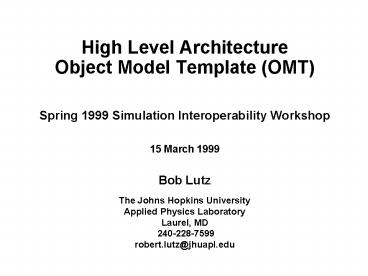High Level Architecture Object Model Template OMT - PowerPoint PPT Presentation
1 / 22
Title:
High Level Architecture Object Model Template OMT
Description:
Data Encoding Table ... Provides a mechanism for defining indexed, homogenous collections of datatypes ... New OMT DIF specification uses XML (eXtensible Markup ... – PowerPoint PPT presentation
Number of Views:94
Avg rating:3.0/5.0
Title: High Level Architecture Object Model Template OMT
1
High Level ArchitectureObject Model Template
(OMT)
- Spring 1999 Simulation Interoperability Workshop
- 15 March 1999
- Bob Lutz
- The Johns Hopkins University
- Applied Physics Laboratory
- Laurel, MD
- 240-228-7599
- robert.lutz_at_jhuapl.edu
2
OMT Additions
- New Tables
- Datatype Tables
- Time Representation Table
- User-Defined Tag Table
- Synchronization Table
- Transportation Type Table
- Switches Table
- New Annexes
- Management Object Model
- Discussed in I/F Spec section
3
Datatype Tables
- Data Encoding Table
- Basic Data Representation Table
- Simple Datatype Table
- Enumerated Datatype Table
- Array Datatype Table
- Fixed Record Datatype Table
- Variant Record Datatype Table
4
Data Encoding Table
Provides a mechanism for defining the arrangement
of bits and bytes within a data item
5
Basic Data Representation Table
Provides a mechanism for defining the fundamental
building blocks for all OMT datatypes
6
Simple Datatype Table
Provides a mechanism for defining the datatype of
simple, scalar data items
7
Enumerated Datatype Table
8
Array Datatype Table
Provides a mechanism for defining indexed,
homogenous collections of datatypes
9
Fixed Record Datatype Table
Provides a mechanism for defining fixed,
heterogenous collections of datatypes
10
Variant Record Datatype Table
Provides a mechanism for defining discriminated
unions of different datatypes
11
Time Representation Table
12
User Defined Tag Table
Provides a mechanism for defining the datatype of
tags that can be associated with certain HLA
services
13
Synchronization Table
14
Transportation Type Table
Provides a mechanism for defining the federation
options for transportation of object attributes
and interactions
15
Switches Table
16
OMT Modifications
- Modified Tables
- Object Model Identification Table
- Object Class Structure Table
- Interaction Class Structure table
- Attribute Table
- Parameter Table
- Routing Space Table
- Modified Annexes
- Common Normalization functions (Annex B)
- OMT DIF (Annex D)
17
Object Model Identification Table
18
Object Class Structure Table
OMT V1.3
OMT P1516.2
19
Interaction Class Structure Table
OMT V1.3
OMT P1516.2
20
Attribute Table
OMT V1.3
OMT P1516.2
21
Parameter Table
OMT V1.3
OMT P1516.2
22
OMT DIF
- Current OMT DIF specification uses BNF
- New OMT DIF specification uses XML (eXtensible
Markup Language) - Technical feasibility and business case well
established - Leverage the collective ideas of industry beyond
our community - Lower costs of maintenance
- Access to a trained work force
- Access to free and commercial supporting software
- OMT and FED DIFs can be combined into single DIF































